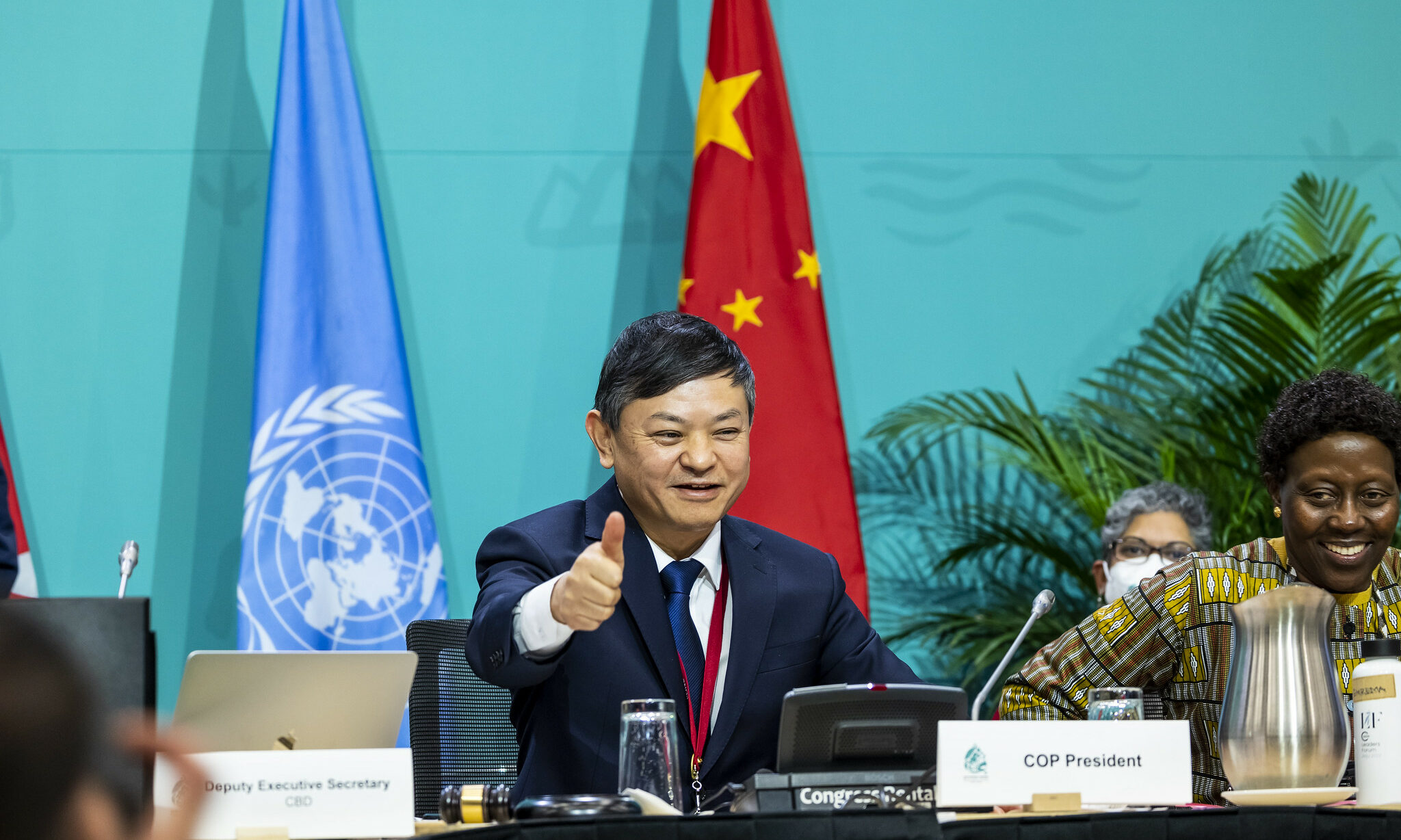At the China-Chaired COP-15 Meeting in Montreal, World Moves to Address the Biodiversity Crisis

Even though the crucial biodiversity summit had to be moved from China to Canada due to the pandemic, Beijing still used the occasion to showcase its diplomatic chops. The final agreement sends a signal of hope for averting the worst scenarios, but also hints that progress on global issues such as biodiversity is possible despite growing political divides.
This article is part of a series of articles authored by young, aspiring China scholars under the Future CHOICE initiative.
The Challenge of Biodiversity Loss
Biodiversity loss, the ‘other’ ecological crisis, has despite its gravity historically received less attention than the consequences of climate change. However, this year, biodiversity entered the spotlight with the international community gathering at the Convention on Biological Diversity (CBD) Conference of Parties (COP) 15 hosted in Canada under the presidency of China, and coming to an agreement on the new Kunming-Montreal Global Biodiversity Framework to address the crisis.
Multiple studies and reports have highlighted the deteriorating state of the Earth’s biodiversity. The WWF Living Planet Report 2022 highlighted that wildlife populations of vertebrates (mammals, birds, reptiles, amphibians, fish) have declined by 69 percent on average since 1970.
Meanwhile, according to estimates by Our World in Data, species extinction rates since 1900 are 100-1000 times higher than natural extinction rates, putting the Earth on course for the sixth mass extinction in its natural history.
In an article published in the journal Biodiversity and Conservation in 2015, the researcher Malcolm McCallum compared vertebrate extinction rates after 1500 and after 1980 with the Cretaceous-Palogene (K-Pg) mass extinction (the event that killed off the dinosaurs around 65 million years ago) and found that vertebrate extinction rates since 1500 are 24-85 times faster than during the Cretaceous mass extinction. More disturbingly, McCallum found that extinction rates since 1980 had accelerated to 71-297 times larger than during the Cretaceous mass extinction. The climate crisis meanwhile risks further intensifying the biodiversity crisis. New research published in December 2022 modelled the impact of global warming on life on Earth, and estimated that more than 1 in 10 species of plants and animals could go extinct by 2100 based on current trends.
China’s Role in Protecting Biodiversity
China, the fourth largest country in the world by area, and home to the largest human population, has an important role to play in protecting the world’s biodiversity. According to Mongabay’s Biodiversity Index, China is ranked the fourth most biodiverse country on Earth due to its rich diversity of species across a range of habitats, from the tropical rainforests in Yunnan Province in the South, to the Gobi Desert in the North. China scores particularly highly for biodiversity of birds, plants, and fish. China is therefore crucial for the continued flourishing of the diversity of life on Earth.
Scientists and environmentalists have been raising the alarm about the biodiversity crisis for some time now and the international community has tried to find ways to address it since the agreement of the CBD at the Rio Earth Summit in 1992. The objectives of the CBD are “the conservation of biological diversity, the sustainable use of its components, and the fair and equitable sharing of the benefits arising from commercial and other utilization of genetic resources. The agreement covers all ecosystems, species, and genetic resources.”
All 196 country parties to the CBD, including China, had subsequently agreed at the 2010 Nagoya Biodiversity Summit in Japan to the Aichi Biodiversity Targets with the aim of halving the loss of natural habitats by 2020. The United Nations (UN) Global Biodiversity Outlook 5 Report published in 2020, however, found that globally none of the Aichi Biodiversity Targets had been achieved by the 2020 deadline, with natural habitats continuing to be lost and many species still threatened by extinction due to human activities.
The Chinese progress towards the Aichi Biodiversity Targets was better than the global average, with China having exceeded three of the 20 targets, those concerning essential ecosystem services, ecosystem resilience, and national biodiversity strategy and action plan. China had also achieved some conservation successes in recent decades, such as with the iconic giant pandas whose numbers increased from 1,000 in the 1980s to over 1,800 at present.
Despite these achievements, biodiversity in China remained under pressure due to factors such as the country’s rapid and extensive urbanization and industrialization, overexploitation of biological resources, and pollution. These pressures resulted in an estimated 15 percent to 20 percent of wild higher plants in China becoming endangered, with 233 vertebrate species facing the threat of extinction.
China’s Play in Montreal
Amid the accelerating biodiversity crisis, China sought to demonstrate global leadership on the issue by stepping up to host and preside over the CBD COP15, which was meant to agree on a new post-2020 Global Biodiversity Framework. China’s plans to host the biggest international biodiversity conference in a decade in the city of Kunming in Yunnan Province in October 2020 were ultimately derailed by the COVID-19 pandemic. The conference was postponed by more than two years, and was finally hosted in Montreal, Canada, the location of the CBD Secretariat, onDecember 7-19 .
China nevertheless retained the presidency of the conference, and with it the opportunity to demonstrate leadership on the biodiversity agenda and showcase its domestic and international efforts on the issue such as its vision for “ecological civilisation” and its steps to green the Belt and Road Initiative. China’s leadership on the global biodiversity agenda arguably has some additional significance as its biggest competitor for primacy on the world stage, the US, is not a party to the CBD, one of only two countries along with the Holy See that have not ratified or acceded to the biodiversity convention.
While the CBD COP15 was meant for the negotiation and agreement of a comprehensive Global Biodiversity Framework, one point received the most attention, the “30×30” conservation target. This target called for 30 percent of the earth’s land and sea to be conserved in protected areas by 2030. It was more ambitious than the analogous Aichi Target that had aimed for the protection of 17 percent of land and 10 percent of coastal and marine areas.
While there was broad support for the principle of the 30×30 conservation target leading up to CBD COP15, there were some concerns about how it would be implemented. Some groups thought that the emphasis in the target might mostly be on the quantity of protected areas, with insufficient consideration for their quality such as whether diverse ecosystems would be conserved and if conservation zones would be interconnected to facilitate species’ movements and migrations especially in light of climate change.
Moreover, due to past negative experiences, indigenous peoples and local communities were meanwhile concerned about conservation implemented in a manner that disregards their rights, livelihoods, and customs. Their concerns are particularly legitimate as there have been prior conservation efforts that removed indigenous peoples’ and local communities’ access to their lands and livelihoods, even though there is research that shows that indigenous-managed lands have equal or higher biodiversity than protected areas.
The negotiations during the CBD COP15 were tough and contentious. Tensions between developed and developing countries particularly over the issue of resource mobilisation for conservation culminated in a walkout midway through the talks by more than 60 developing countries, including the two most biodiverse countries on Earth, Brazil and Indonesia.
Developing countries were frustrated that while there had been progress on talks over how much land and sea should be set aside for protection, discussions over the financing of such efforts had lagged behind even though the burden of conservation would primarily be borne by the more biodiverse Global South.
Meanwhile, the developed countries grew increasingly irked about the fact that the large developing countries that had experienced economic growth since the CBD was first agreed in 1992, like Brazil and notably China, are still recipients of environmental finance without having to make contributions. As President of COP 15, China’s role was to forge a consensus agreement at the conference. China had to exercise its diplomatic skills to resolve the tensions and bring Parties back together to the negotiating table to agree on the Global Biodiversity Framework.
Finally, in the early morning Canadian time on December 19, two weeks of intense negotiations concluded and Parties successfully adopted the new “Kunming-Montreal Global Biodiversity Framework” (GBF).
Challenging Road Ahead
The GBF includes four goals and 23 targets to be achieved by 2030. Among the targets was the headline objective, the “effective conservation and management of at least 30 percent of the world’s lands, inland waters, coastal areas and oceans” by 2030. Crucially for indigenous peoples and local communities, this target recognizes indigenous and traditional territories and practices, therefore including them in conservation efforts going forward. Another GBF target meanwhile aims to “raise international financial flows from developed to developing countries,in particular least developed countries, small island developing States, and countries with economies in transition, to at least $20 billion per year by 2025, and to at least $30 billion per year by 2030.”
Significantly, the financial mobilisation target includes a subclause for “countries that voluntarily assume obligations of developed country Parties” to also contribute to international biodiversity financing for developing countries. The subclause represents a compromise between developed countries and developing countries like China that are increasingly well-resourced. This is because it opens a path towards the Chinese eventually facing calls to also pay to help others, notably least developed countries and small island developing states, conserve their biodiversity.
Environmental groups welcomed the new GBF and the opportunity it presents to address the biodiversity crisis in a just manner, while cautioning that the framework lacked a mechanism to ratchet-up biodiversity ambition. Hence, civil society would need to continue to mobilise to hold governments accountable to their biodiversity commitments. The productive working relationship between the President of COP 15 China and the host country Canada during the conference, which enabled the successful agreement on the GBF was also praised. China and Canada were able to cooperate on biodiversity despite deep disagreements on many other issues such as human rights.
The relatively successful outcome of COP 15 under the Presidency of China arguably demonstrates China’s ability and willingness to assume leadership on issues of global importance. The dynamic between China and Canada at COP 15 meanwhile offers hope that even as disagreements increase between China and the West both sides can still find ways to cooperate on environmental issues.
Nevertheless, the real test of the success of the Kunming-Montreal Global Biodiversity Framework will be in its implementation. Having helped steer negotiations towards agreement on the GBF and as one of the world’s most biodiverse countries, China’s role in implementation will be crucial in determining if the world can effectively address the biodiversity crisis and prevent the sixth mass extinction.
Written by
Julian Theseira
Julian Theseira coordinates the Global Stocktake (GST) Working Group of the Climate Action Network (CAN). He is also a research assistant at the Association for International Affairs (AMO), in Prague, Czech Republic, and Erasmus Mundus scholar in the European Politics and Society (EPS) Master program at Charles University, Prague, and Jagiellonian University, Krakow.


